Signal Quality Analysis of Single-Arm Electrocardiography
Abstract
1. Introduction
2. Materials and Methods
2.1. Single-Arm ECG
2.2. Protocol of Experiment
2.3. Extraction of ECG Parameters
2.4. Statistical Analysis
3. Results
4. Discussion
5. Conclusions
Author Contributions
Funding
Institutional Review Board Statement
Informed Consent Statement
Acknowledgments
Conflicts of Interest
References
- Taelman, J.; Vandeput, S.; Vlemincx, E.; Spaepen, A.; van Huffel, S. Instantaneous changes in heart rate regulation dueto mental load in simulated office work. Eur. J. Appl. Physiol. 2011, 111, 1497–1505. [Google Scholar] [CrossRef] [PubMed]
- Kivimaki, M. Work stress and risk of cardiovascular mortality: Prospective cohort study of industrial employees. Br. Med. J. 2002, 325, 857–860. [Google Scholar] [CrossRef]
- Esch, T.; Stefano, G.B.; Fricchione, G.L.; Benson, H. Stress in cardiovascular diseases. Med. Sci. Monit. 2002, 8, RA93–RA101. [Google Scholar] [PubMed]
- Esch, T.; Stefano, G.B.; Fricchione, G.L.; Benson, H. The role of stress in neurodegenerative diseases and mental disorders. Neuroendocrinol. Lett. 2002, 23, 199–208. [Google Scholar]
- Miller, G.E.; Chen, E.; Parker, K.J. Psychological stress in childhood and susceptibility to the chronic diseases of aging: Moving toward a model of behavioral and biological mechanisms. Psychol. Bull. 2011, 137, 959–997. [Google Scholar] [PubMed]
- Rosmond, R. Role of stress in the pathogenesis of the metabolic syndrome. Psychoneuroendocrinology 2005, 30, 1–10. [Google Scholar] [CrossRef]
- Bhatt, V.; Chakraborty, S.; Chakravorty, T.; Studies, E. Importance of digitech adoption for providing efficient healthcare services during COVID-19. Int. J. Emerg. Technol. 2020, 11, 1–13. [Google Scholar]
- Mach, S.; Storozynski, P.; Halama, J.; Krems, J.F. Assessing mental workload with wearable devices—Reliability and applicability of heart rate and motion measurements. Appl. Ergon. 2022, 105, 103855. [Google Scholar] [CrossRef]
- Van Acker, B.B.; Parmentier, D.D.; Vlerick, P.; Saldien, J. Understanding mental workload: From a clarifying concept analysis toward an implementable framework. Cogn. Technol. Work. 2018, 20, 351–365. [Google Scholar] [CrossRef]
- Putz, S.; Rick, V.; Mertens, A.; Nitsch, V. Using IoT devices for sensor-based monitoring of employees’ mental workload: Investigating managers’ expectations and concerns. Appl. Ergon. 2022, 102, 103739. [Google Scholar] [CrossRef]
- Behar, J.A.; Oster, J.; De Vos, M.; Clifford, G.D. Wearables and mHealth in mental health and neurological disorders. Physiol. Meas. 2019, 40, 070401. [Google Scholar] [CrossRef] [PubMed]
- Hart, S.G.; Staveland, L.E. Development of NASA-TLX (Task Load Index): Results of empirical and theoretical research. Adv. Psychol. 1988, 52, 139–183. [Google Scholar]
- de Winter, J.C. Controversy in human factors constructs and the explosive use of the NASA-TLX: A measurement perspective. Cogn. Technol. Work. 2014, 16, 289–297. [Google Scholar] [CrossRef]
- Van Acker, B.B.; Bombeke, K.; Durnez, W.; Parmentier, D.D.; Mateus, J.C.; Biondi, A.; Saldien, J.; Vlerick, P. Mobile pupillometry in manual assembly: A pilot study exploring the wearability and external validity of a renowned mental workload lab measure. Int. J. Ind. Ergon. 2020, 75, 102891. [Google Scholar] [CrossRef]
- Vanneste, P.; Raes, A.; Morton, J.; Bombeke, K.; Van Acker, B.B.; Larmuseau, C.; Depaepe, F.; Van den Noortgate, W. Towards measuring cognitive load through multimodal physiological data. Cogn. Technol. Work 2021, 23, 567–585. [Google Scholar] [CrossRef]
- Herff, C.; Heger, D.; Fortmann, O.; Hennrich, J.; Putze, F.; Schultz, T. Mental workload during n-back task-quantified in the prefrontal cortex using fNIRS. Front. Hum. Neurosci. 2013, 7, 935. [Google Scholar] [CrossRef]
- Hankins, T.C.; Wilson, G.F. A comparison of heart rate, eye activity, EEG and subjective measures of pilot mental workload during flight. Aviat. Space Environ. Med. 1998, 69, 360–367. [Google Scholar]
- Lobodzinski, S.S.; Laks, M.M. New devices for very long-term ECG monitoring. Cardiol. J. 2012, 19, 210–214. [Google Scholar] [CrossRef]
- Liu, S.-H.; Wang, J.-J.; Su, C.-H.; Tan, T.-H. Development of a patch-type electrocardiographic monitor for real time heartbeat detection and heart rate variability analysis. J. Med. Biol. Eng. 2018, 38, 411–423. [Google Scholar] [CrossRef]
- Liu, S.-H.; Lin, C.-B.; Chen, Y.; Chen, W.; Huang, T.-S.; Hsu, C.-Y. An EMG patch for the real-time monitoring of muscle-fatigue conditions during exercise. Sensors 2019, 19, 3108. [Google Scholar] [CrossRef]
- Liu, S.-H.; Liu, H.-C.; Chen, W.; Tan, T.-H. Evaluating quality of photoplethymographic signal on wearable forehead pulse oximeter with supervised classification approaches. IEEE Access 2020, 8, 185121–185135. [Google Scholar]
- Rachim, V.P.; Chung, W.Y. Wearable-band type visible-near infrared optical biosensor for non-invasive blood glucose monitoring. Sens. Actuators B-Chem. 2019, 286, 173–180. [Google Scholar]
- Liu, S.-H.; Wang, J.-J.; Chen, W.; Pan, K.-L.; Su, C.-H. An examination system to detect deep vein thrombosis of a lower limb using light reflection rheography. Sensors 2021, 21, 2446. [Google Scholar] [PubMed]
- Liu, S.-H.; Chen, W.; Su, C.-H.; Pan, K.-L. Convolutional neural network-based detection of deep vein thrombosis in a low limb with light reflection rheography. Measurement 2022, 189, 110457. [Google Scholar]
- Gallardo, J.; Bellone, G.; Plano, S.; Vigo, D.; Risk, M. Heart rate variability: Influence of pre-processing methods in identifying single-night sleep-deprived subjects. J. Med. Biol. Eng. 2021, 41, 224–230. [Google Scholar]
- Tao, D.; Tan, H.; Wang, H.; Zhang, X.; Qu, X.; Zhang, T. A systematic review of physiological measures of mental workload. Int. J. Environ. Res. Public Health 2019, 16, 2716. [Google Scholar]
- Liu, S.-H.; Cheng, D.-C.; Wang, J.-J.; Lin, T.-H.; Chang, K.-M. Effects of moderate exercise on relieving mental load of elementary school teachers. Evid.-Based Complement. Altern. Med. 2015, 2015, 192680. [Google Scholar]
- Liu, S.-H.; Lin, T.-H.; Chang, K.-M. The physical effects of aromatherapy in alleviating work-related stress on elementary school teachers in Taiwan. Evid.-Based Complement. Altern. Med. 2013, 2013, 853809. [Google Scholar]
- Schäfer, A.; Vagedes, J. How accurate is pulse rate variability as an estimate of heart rate variability? A review on studies comparing photoplethysmographic technology with an electrocardiogram. Int. J. Cardiol. 2013, 166, 15–29. [Google Scholar]
- Mejía-Mejía, E.; May, J.M.; Torres, R.; Kyriacou, P.A. Pulse rate variability in cardiovascular health: A review on its applications and relationship with heart rate variability. Physiol. Meas. 2020, 41, 07TR01. [Google Scholar]
- Young, H.A.; Benton, D. Heart-rate variability: A biomarker to study the influence of nutrition on physiological and psychological health? Behav. Pharmacol. 2018, 29, 140–151. [Google Scholar] [CrossRef]
- Jarczok, M.N.; Koenig, J.; Mauss, D.; Fischer, J.E.; Thayer, J.F. Lower heart rate variability predicts increased level of C-reactive protein 4 years later in healthy, nonsmoking adults. J. Intern. Med. 2014, 276, 667–671. [Google Scholar] [CrossRef]
- Singh, J.P.; Larson, M.G.; O’Donnell, C.J.; Wilson, P.F.; Tsuji, H.; Lloyd-Jones, D.M.; Levy, D. Association of hyperglycemia with reduced heart rate variability. Am. J. Cardiol. 2000, 86, 309–312. [Google Scholar] [CrossRef] [PubMed]
- Lopresti, A.L. Association between micronutrients and heart rate variability: A review of human studies. Adv. Nutr. 2020, 11, 559–575. [Google Scholar] [CrossRef] [PubMed]
- Pan, J.; Tompkins, W.J. A real-time QRS detection algorithm. IEEE Trans. Biomed. Eng. 1985, 32, 230–236. [Google Scholar] [CrossRef]
- Apple, ResearchKit/ResearchKit: ResearchKit 1.5.3. Available online: https://www.apple.com/tw/researchkit/ (accessed on 1 May 2023).
- Take an ECG with the ECG App on Apple Watch. Available online: https://support.apple.com/en-us/HT208955 (accessed on 1 May 2023).
- Sharma, A.N.; Baranchuk, A. Ambulatory external electrocardiography monitoring: Holter, extended Holter, mobile cardiac telemetry monitoring. Card. Electrophysiol. Clin. Biol. 2021, 13, 427–438. [Google Scholar] [CrossRef] [PubMed]
- Liu, S.-H. Motion artifact reduction in electrocardiogram using adaptive filter. J. Med. Biol. Eng. 2011, 31, 67–72. [Google Scholar] [CrossRef]
- Chang, K.-M.; Liu, S.-H. Gaussian noise filtering from ECG by wiener filter and ensemble empirical mode decomposition. J. Signal Process. Syst. Signal Image Video Technol. 2011, 64, 249–264. [Google Scholar] [CrossRef]
- Schlink, B.R.; Nordin, A.D.; Ferris, D.P. Comparison of signal processing methods for reducing motion artifacts in high-density electromyography during human locomotion. IEEE Open J. Eng. Med. Biol. 2020, 1, 156–165. [Google Scholar] [CrossRef]

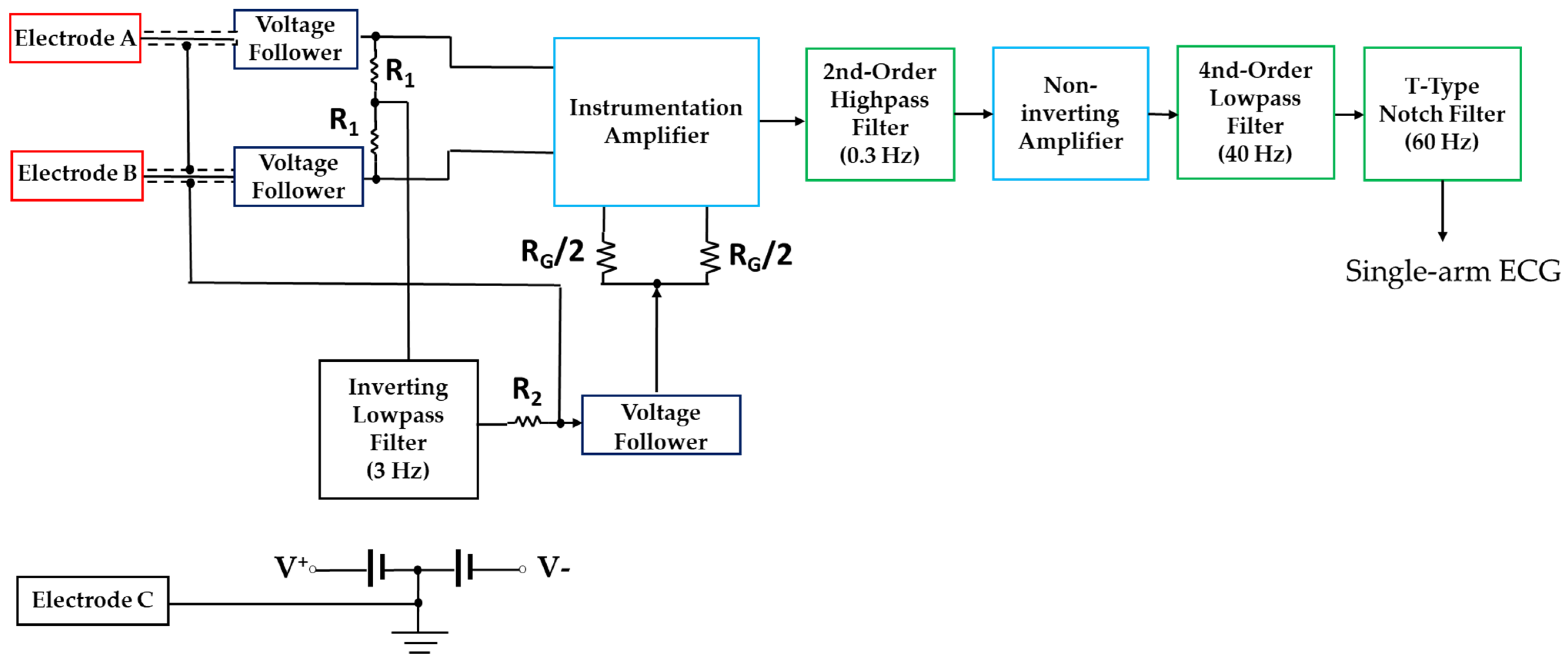
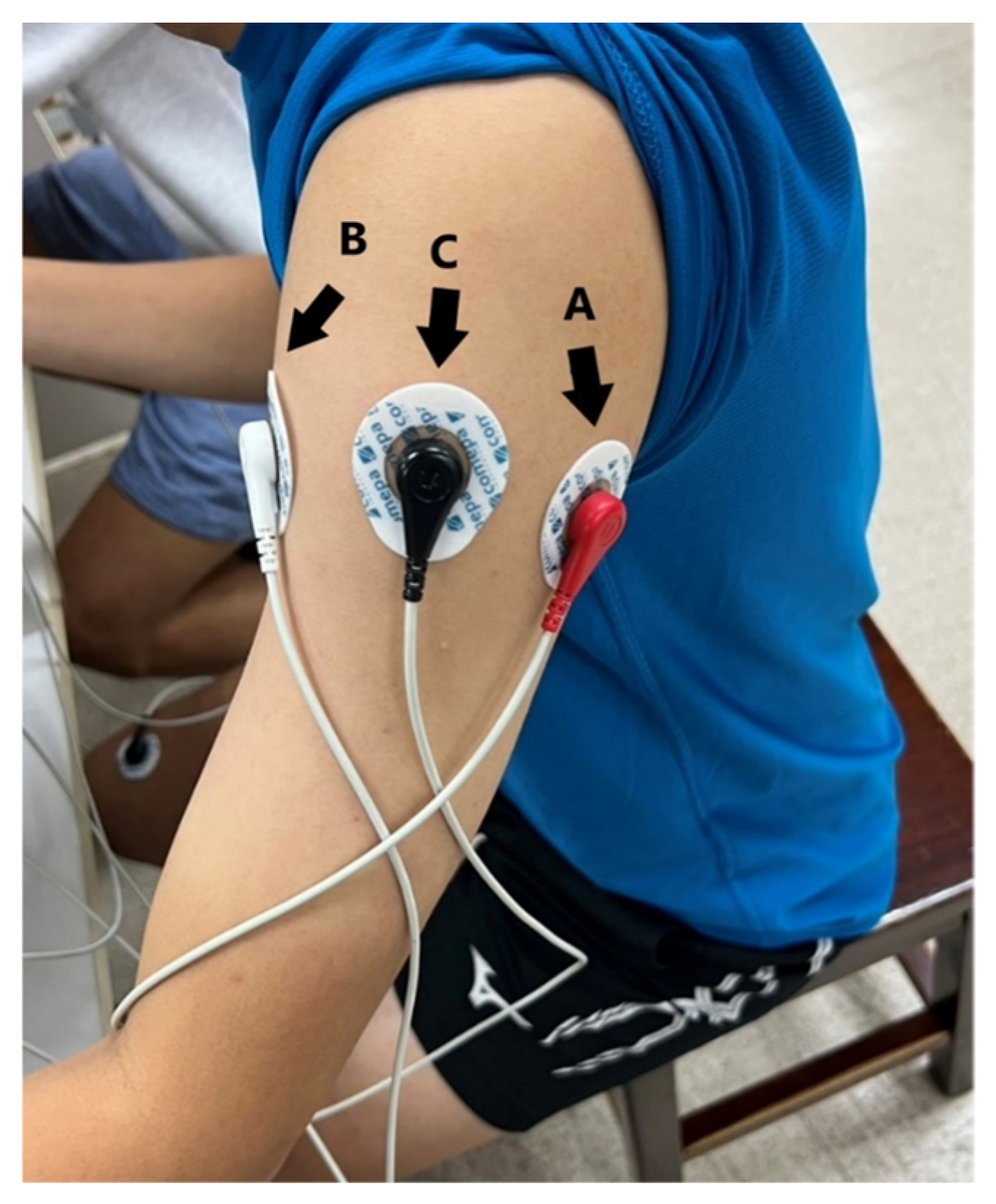

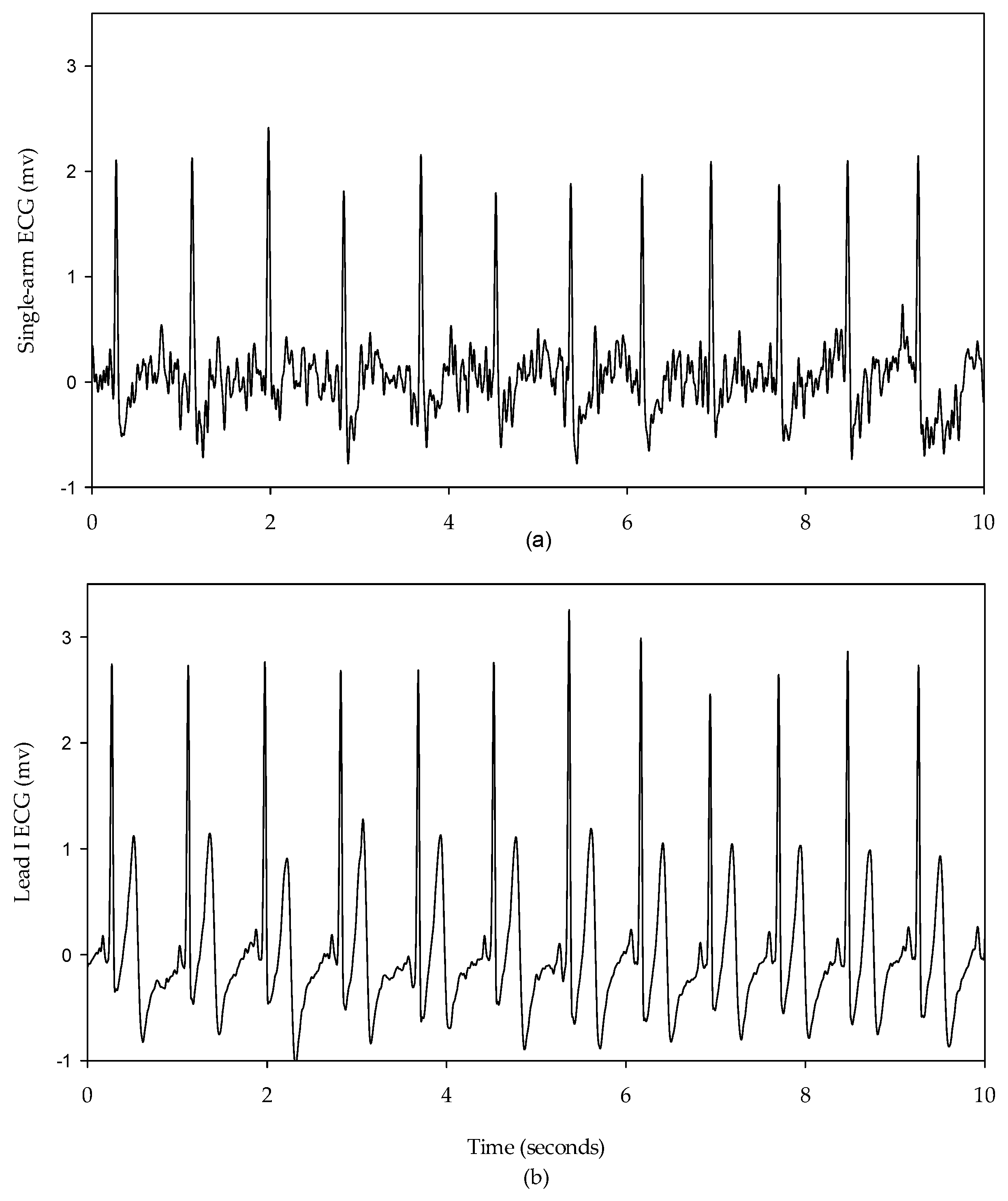
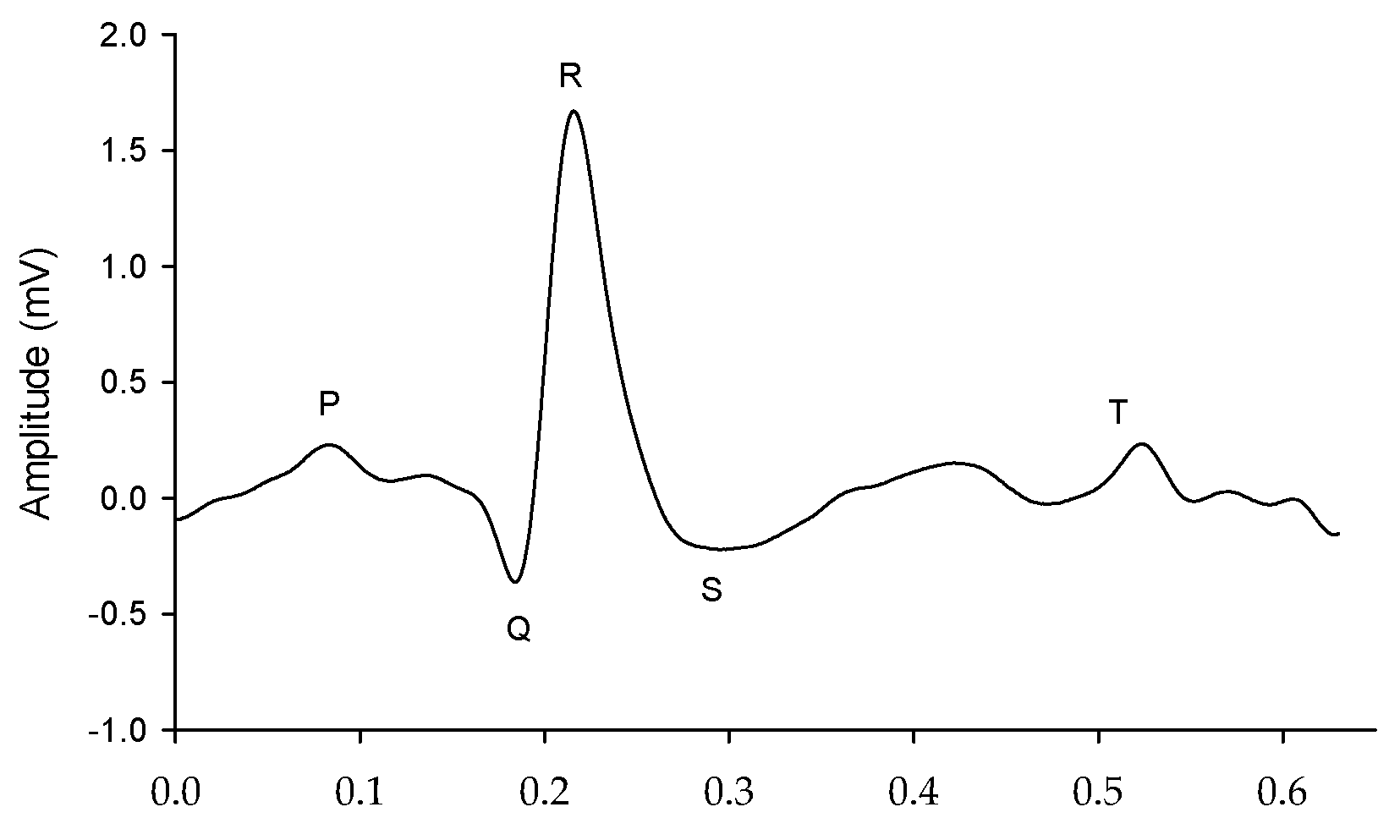
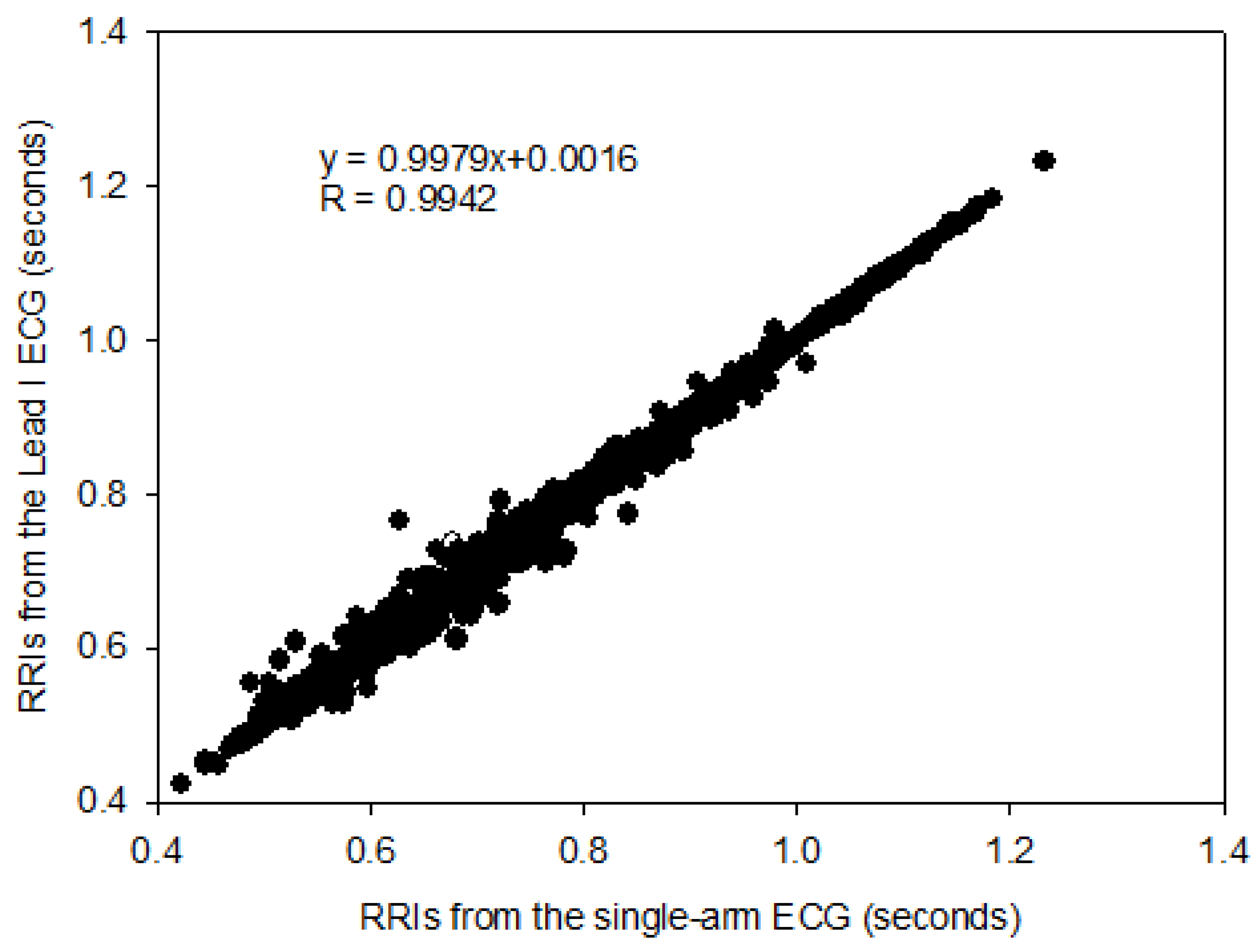


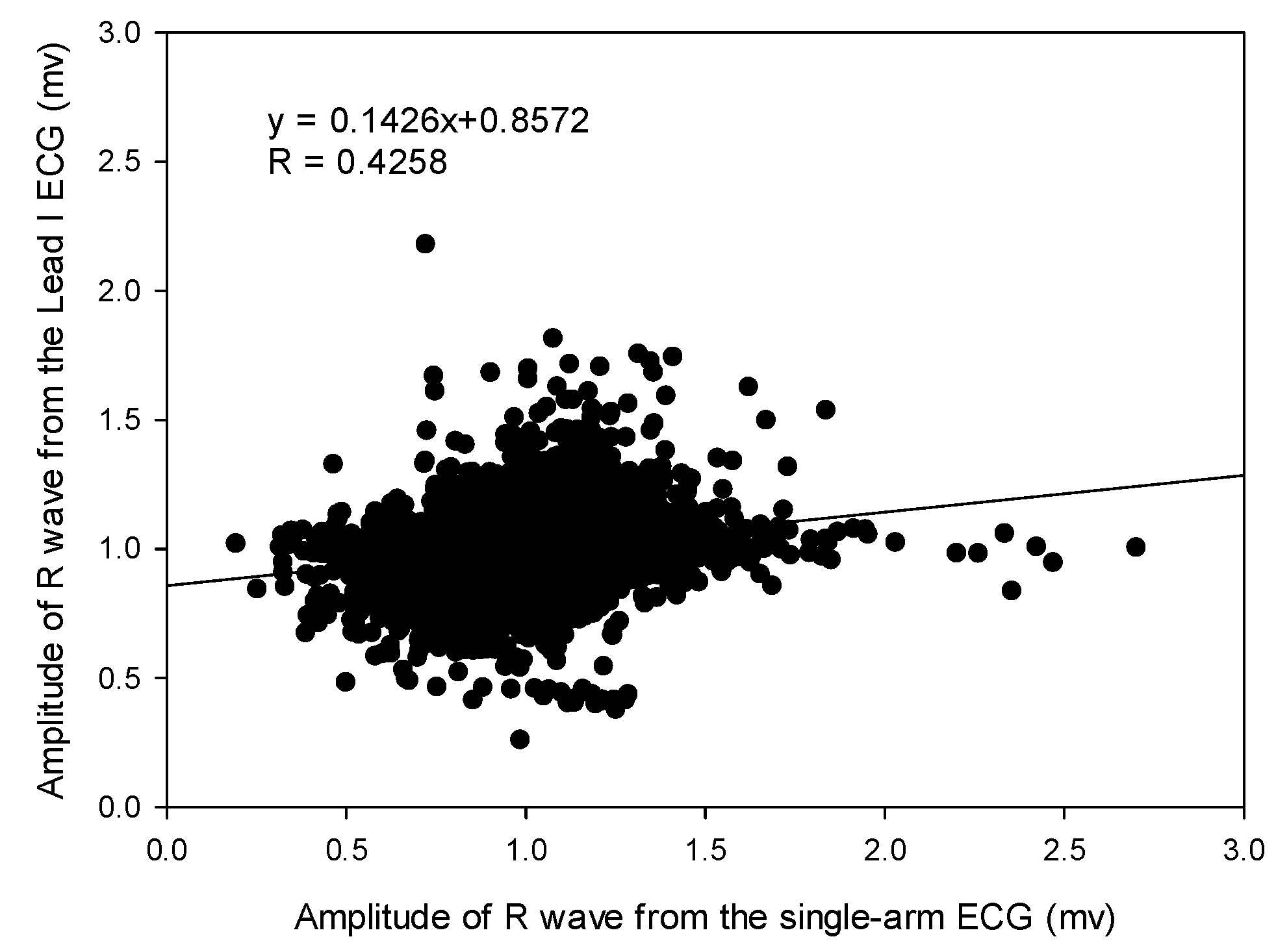
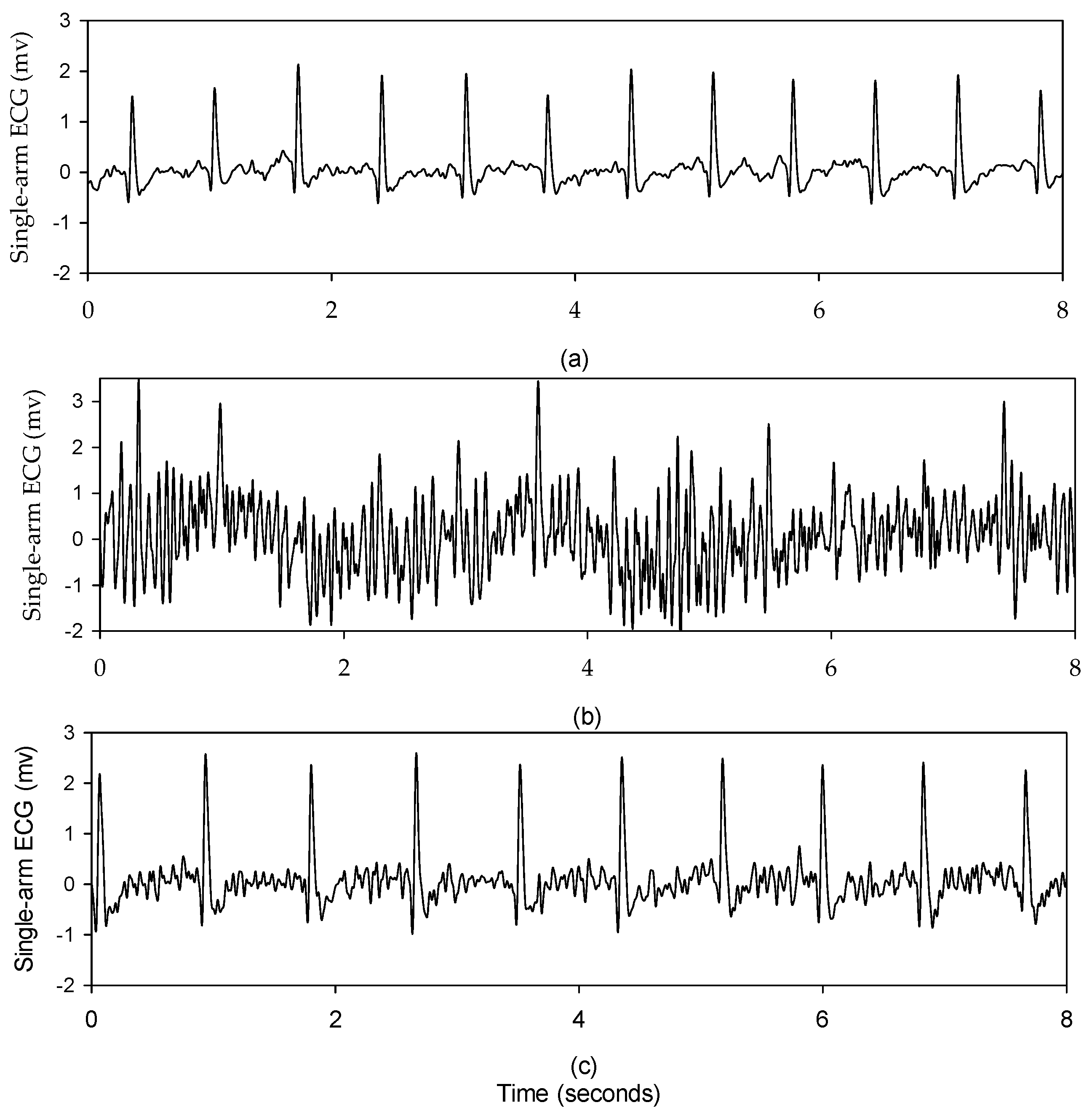

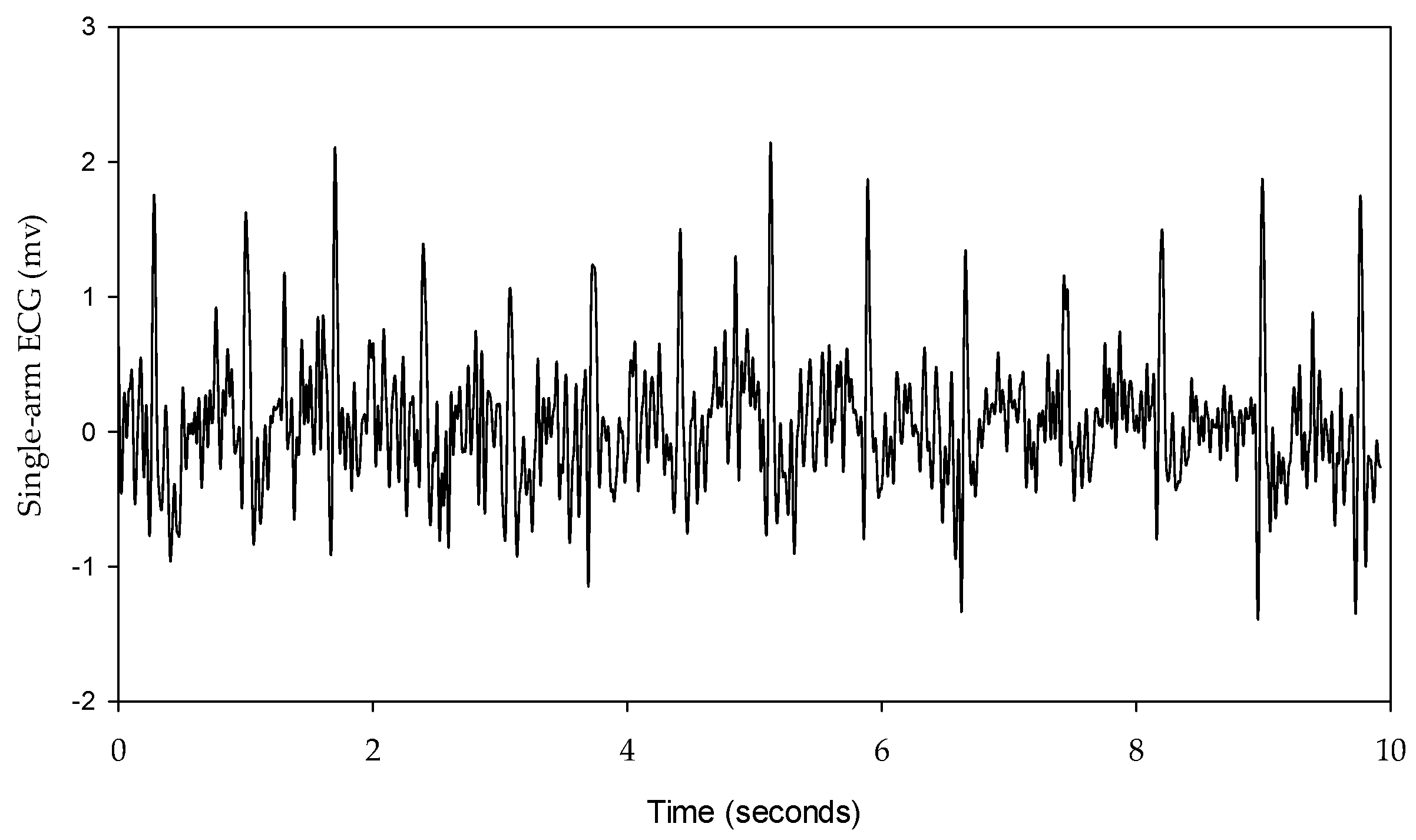
| No. | Experiment | Protocol |
|---|---|---|
| 1 | Resting | Subjects in a sitting position were asked to take a rest at least three minutes to allow their hemodynamic status to become stable before the ECG measurement began. Subjects put their two arms on a table relaxedly. In the resting activity, 30 s single-arm and lead I ECGs were simultaneously registered. |
| 2 | Palm opening and clenching | Subject were asked to put their arms on the table, stretch their arms, and continuously open and clench their left palm 10 times. Each opening and clenching of the palm lasted 3 s. Then, subjects were asked to take a rest for three minutes. |
| 3 | Forearm moving | Subject were asked to put their arms on the table, stretch their arms, and raise their left forearm from 0° to 90° and 90° to 0° 10 times. Each movement lasted 3 s. Then, subjects were asked to take a rest for three minutes. |
| 4 | Arm horizontally moving along y-axis | Subjects in a standing position were asked to raise their left arm to 90° and horizontally move their arm 10 times. The moving angle was 90°. Each movement lasted 3 s. Then, subjects were asked to take a rest for three minutes. |
| 5 | Arm raising and lowering along x-axis | Subjects in a standing position were asked to raise their left arm and lower their arm in the horizontal direction 10 times. The moving angle was 90°. Each movement lasted 3 s. Then, subjects were asked to take a rest for three minutes. |
| 6 | Arm raising and lowering along z-axis | Subjects in a standing position were asked to raise their left arm and lower their arm in the vertical direction 10 times. The moving angle was 90°. Each movement lasted 3 s. Then, subjects were asked to take a rest for three minutes. |
| 7 | Valsalva maneuver | Subjects performed the Valsalva maneuver by blowing into a rubber tube connected to a mercury column sphygmomanometer and maintaining a pressure of 50 mm Hg for 10 s. Then, subjects were asked to take a rest for three minutes. |
| Sub. | Resting | Palm Opening and Clenching | Forearm Moving | Arm Horizontally Moving in y-Axis | Arm Raising and Lowering in x-Axis | Arm Raising and Lowering in z-Axis | Valsalva Maneuver |
|---|---|---|---|---|---|---|---|
| 1 | 5.6 | 4.1 | 5.8 | 4.053 | 4.053 | 4.023 | 6.120 |
| 2 | 11.0 | 14.4 | 8.8 | 3.783 | 2.918 | 2.780 | 31.740 |
| 3 | 45.2 | 35.0 | 15.5 | 3.805 | 4.282 | 3.976 | 24.733 |
| 4 | 23.6 | 38.6 | 7.8 | 3.633 | 2.416 | 2.198 | 34.865 |
| 5 | 25.7 | 17.7 | 12.0 | 5.812 | 5.338 | 5.726 | 8.203 |
| 6 | 23.8 | 19.5 | 6.4 | 2.499 | 3.466 | 2.677 | 26.281 |
| 7 | 79.3 | 26.8 | 8.7 | 10.351 | 2.014 | 7.185 | 12.603 |
| 8 | 17.3 | 28.6 | 16.5 | 5.063 | 4.892 | 5.602 | 12.390 |
| 9 | 46.8 | 4.4 | 5.9 | 4.358 | 3.984 | 4.520 | 19.101 |
| 10 | 21.4 | 17.9 | 6.4 | 6.647 | 7.198 | 4.574 | 28.793 |
| 11 | 20.7 | 166.1 | 21.2 | 3.875 | 8.343 | 4.303 | 15.002 |
| 12 | 24.5 | 8.3 | 10.622 | 2.591 | 2.747 | 2.022 | 8.545 |
| 13 | 59.0 | 39.5 | 36.921 | 8.536 | 11.209 | 6.967 | 34.430 |
| 14 | 34.2 | 7.4 | 6.976 | 2.049 | 2.256 | 2.162 | 17.363 |
| 15 | 17.6 | 10.0 | 3.893 | 5.497 | 6.829 | 4.822 | 6.820 |
| 16 | 20.7 | 15.8 | 5.778 | 5.754 | 9.902 | 7.586 | 13.984 |
| 17 | 19.9 | 27.6 | 7.913 | 7.454 | 19.066 | 52.994 | 16.338 |
| 18 | 16.1 | 6.3 | 10.957 | 4.433 | 1.869 | 2.095 | 6.386 |
| 19 | 58.9 | 23.5 | 30.860 | 13.050 | 6.246 | 4.917 | 46.567 |
| 20 | 10.1 | 42.8 | 11.698 | 5.628 | 5.058 | 5.960 | 12.646 |
| 21 | 16.0 | 20.9 | 13.408 | 6.294 | 6.306 | 6.426 | 20.706 |
| 22 | 13.3 | 9.8 | 8.118 | 7.815 | 4.186 | 6.109 | 7.315 |
| 23 | 12.8 | 30.2 | 6.869 | 7.852 | 8.319 | 7.893 | 16.724 |
| 24 | 10.9 | 12.1 | 3.178 | 2.521 | 2.761 | 3.113 | 9.533 |
| 25 | 9.5 | 25.7 | 4.705 | 7.336 | 6.933 | 5.008 | 20.319 |
| 26 | 49.6 | 17.0 | 15.197 | 3.253 | 2.172 | 2.622 | 48.128 |
| 27 | 24.3 | 12.9 | 7.831 | 9.014 | 6.238 | 7.089 | 18.459 |
| 28 | 14.7 | 7.7 | 14.124 | 5.397 | 3.550 | 4.790 | 18.746 |
| 29 | 56.0 | 67.0 | 31.940 | 6.612 | 4.984 | 5.513 | 34.386 |
| 30 | 20.0 | 18.3 | 5.285 | 4.498 | 3.312 | 2.409 | 13.245 |
| Mean ± SD (dB) | 26.1 ± 5.9 | 23.5 ± 7.4 | 18.3 ± 5.5 ** | 13.1 ± 3.8 ** | 12.6 ± 5.5 ** | 12.5 ± 5.1 ** | 23.0 ± 7.4 |
| Sub. | Resting | Palm Opening and Clenching | Forearm Moving | Arm Horizontally Moving in y-Axis | Arm Raising and Lowering in x-Axis | Arm Raising and Lowering in z-Axis | Valsalva Maneuver |
|---|---|---|---|---|---|---|---|
| 1 | 0.9980 | 0.9881 | 0.9961 | 0.9919 | 0.9986 | 0.9971 | 0.9994 |
| 2 | 0.9992 | 0.9982 | 0.9983 | 0.9909 | 0.9944 | 0.9979 | 0.9996 |
| 3 | 0.9991 | 0.9964 | 0.9975 | 0.9699 | 0.9655 | 0.9222 | 0.9998 |
| 4 | 0.9983 | 0.9997 | 0.9977 | 0.9812 | 0.9760 | 0.8991 | 0.9599 |
| 5 | 0.9477 | 0.9920 | 0.9997 | 0.9863 | 0.9908 | 0.9992 | 0.9992 |
| 6 | 0.9994 | 0.9998 | 0.9986 | 0.8852 | 0.9954 | 0.9918 | 0.9199 |
| 7 | 0.9671 | 0.9997 | 0.9956 | 0.9983 | 0.9505 | 0.9991 | 0.9998 |
| 8 | 0.9964 | 0.9990 | 0.9987 | 0.9878 | 0.9977 | 0.9887 | 0.9997 |
| 9 | 0.9997 | 0.9980 | 0.9968 | 0.9970 | 0.9985 | 0.9974 | 0.9998 |
| 10 | 0.9989 | 0.9992 | 0.9977 | 0.9973 | 0.9987 | 0.9975 | 0.9995 |
| 11 | 0.9989 | 0.9985 | 0.9958 | 0.9865 | 0.9758 | 0.9712 | 0.9996 |
| 12 | 0.9998 | 0.9953 | 0.9974 | 0.9521 | 0.9544 | 0.9550 | 0.9599 |
| 13 | 0.9996 | 0.9978 | 0.9770 | 0.9934 | 0.9812 | 0.9989 | 0.9998 |
| 14 | 0.9994 | 0.9968 | 0.9967 | 0.8561 | 0.8207 | 0.8054 | 0.9957 |
| 15 | 0.9969 | 0.8431 | 0.8867 | 0.9764 | 0.9869 | 0.9829 | 0.9991 |
| 16 | 0.9998 | 0.9993 | 0.9966 | 0.9894 | 0.9987 | 0.9990 | 0.9997 |
| 17 | 0.9975 | 0.9997 | 0.9952 | 0.9796 | 0.9554 | 0.9438 | 0.9999 |
| 18 | 0.9994 | 0.9837 | 0.9981 | 0.9953 | 0.9413 | 0.9137 | 0.9918 |
| 19 | 0.9991 | 0.9948 | 0.9945 | 0.9981 | 0.9759 | 0.9527 | 0.9998 |
| 20 | 0.9970 | 0.9972 | 0.9978 | 0.9713 | 0.9633 | 0.9913 | 0.9948 |
| 21 | 0.9993 | 0.9962 | 0.9975 | 0.9978 | 0.9926 | 0.9945 | 0.9997 |
| 22 | 0.9998 | 0.9999 | 0.9991 | 0.9996 | 0.9985 | 0.9992 | 0.9994 |
| 23 | 0.9984 | 0.9986 | 0.9966 | 0.9997 | 0.9996 | 0.9987 | 0.9997 |
| 24 | 0.9995 | 0.9989 | 0.9753 | 0.9833 | 0.9836 | 0.9968 | 0.9799 |
| 25 | 0.9988 | 0.9991 | 0.9962 | 0.9973 | 0.9975 | 0.9960 | 0.9996 |
| 26 | 0.9996 | 0.9992 | 0.9994 | 0.9953 | 0.9198 | 0.9687 | 0.9995 |
| 27 | 0.9990 | 0.9987 | 0.9980 | 0.9982 | 0.9494 | 0.9917 | 0.9998 |
| 28 | 0.9996 | 0.9988 | 0.9994 | 0.9881 | 0.9941 | 0.9368 | 0.9997 |
| 29 | 0.9995 | 0.9977 | 0.9991 | 0.9898 | 0.9823 | 0.9997 | 0.9999 |
| 30 | 0.9997 | 0.9998 | 0.9997 | 0.9980 | 0.9984 | 0.9963 | 0.9996 |
| Mean ± SD | 0.996 ± 0.012 | 0.992 ± 0.028 | 0.992 ± 0.0217 | 0.981 ± 0.032 | 0.974 ± 0.036 | 0.973 ± 0.043 | 0.993 ± 0.017 |
| Sub. | Resting | Palm Opening and Clenching | Forearm Moving | Arm Horizontally Moving in y-Axis | Arm Raising and Lowering in x-Axis | Arm Raising and Lowering in z-Axis | Valsalva Maneuver |
|---|---|---|---|---|---|---|---|
| 1 | 0.1375 | 0.3293 | 0.0400 | 0.2205 | 0.2280 | 0.1353 | 0.0283 |
| 2 | 0.2159 | 0.1729 | 0.0600 | 0.3059 | 0.1490 | 0.2307 | 0.0202 |
| 3 | 0.1732 | 0.0100 | 0.3869 | 0.2665 | 0.3437 | 0.1140 | 0.1389 |
| 4 | 0.2114 | 0.2490 | 0.0100 | 0.0663 | 0.0714 | 0.0469 | 0.1411 |
| 5 | 0.5119 | 0.4051 | 0.3200 | 0.4848 | 0.0794 | 0.0300 | 0.3074 |
| 6 | 0.1253 | 0.3176 | 0.1237 | 0.4601 | 0.0781 | 0.1257 | 0.1233 |
| 7 | 0.2791 | 0.0943 | 0.5001 | 0.0003 | 0.3490 | 0.2528 | 0.1371 |
| 8 | 0.3162 | 0.2149 | 0.1761 | 0.1552 | 0.0843 | 0.1049 | 0.3082 |
| 9 | 0.3030 | 0.3777 | 0.2258 | 0.2848 | 0.0557 | 0.1490 | 0.0975 |
| 10 | 0.1539 | 0.1676 | 0.1296 | 0.3709 | 0.1720 | 0.2012 | 0.0283 |
| 11 | 0.1068 | 0.2784 | 0.4156 | 0.4413 | 0.3338 | 0.3719 | 0.4030 |
| 12 | 0.3361 | 0.0374 | 0.0361 | 0.2390 | 0.0922 | 0.3053 | 0.1356 |
| 13 | 0.3897 | 0.2352 | 0.1459 | 0.1020 | 0.5039 | 0.1265 | 0.1552 |
| 14 | 0.2114 | 0.0361 | 0.0678 | 0.2798 | 0.1847 | 0.0469 | 0.3592 |
| 15 | 0.1872 | 0.2274 | 0.0447 | 0.1237 | 0.1817 | 0.2324 | 0.0959 |
| 16 | 0.3856 | 0.0608 | 0.1407 | 0.3158 | 0.0775 | 0.2828 | 0.0080 |
| 17 | 0.1707 | 0.3098 | 0.1634 | 0.0020 | 0.1884 | 0.0985 | 0.2583 |
| 18 | 0.1224 | 0.0141 | 0.1414 | 0.0917 | 0.1520 | 0.1700 | 0.0843 |
| 19 | 0.1712 | 0.3966 | 0.0374 | 0.0245 | 0.2655 | 0.0800 | 0.1153 |
| 20 | 0.2015 | 0.2315 | 0.3214 | 0.2140 | 0.2377 | 0.0608 | 0.0883 |
| 21 | 0.5217 | 0.0520 | 0.3581 | 0.0245 | 0.1910 | 0.5675 | 0.2561 |
| 22 | 0.1794 | 0.2615 | 0.4159 | 0.4287 | 0.0911 | 0.0894 | 0.1221 |
| 23 | 0.4643 | 0.1245 | 0.3941 | 0.2128 | 0.0283 | 0.4315 | 0.4845 |
| 24 | 0.2914 | 0.2746 | 0.3908 | 0.1058 | 0.0173 | 0.4887 | 0.0265 |
| 25 | 0.1281 | 0.0877 | 0.0224 | 0.0265 | 0.2782 | 0.0566 | 0.2364 |
| 26 | 0.1342 | 0.2458 | 0.3373 | 0.2285 | 0.4591 | 0.5993 | 0.1876 |
| 27 | 0.1332 | 0.5253 | 0.4438 | 0.6226 | 0.5657 | 0.4860 | 0.4874 |
| 28 | 0.2374 | 0.6227 | 0.2651 | 0.5542 | 0.3685 | 0.5631 | 0.1253 |
| 29 | 0.1456 | 0.0566 | 0.2184 | 0.4426 | 0.5031 | 0.3350 | 0.0412 |
| 30 | 0.2236 | 0.2742 | 0.0592 | 0.0300 | 0.0436 | 0.1396 | 0.1825 |
| Mean ± SD | 0.240 ± 0.118 | 0.223 ± 0.152 | 0.213 ± 0.152 | 0.237 ± 0.177 | 0.212 ± 0.154 | 0.230 ± 0.174 | 0.172 ± 0.132 |
| Sub. | Resting | Palm Opening and Clenching | Forearm Moving | Arm Horizontally Moving in y-Axis | Arm Raising and Lowering in x-Axis | Arm RAISING and lowering in z-Axis | Valsalva Maneuver |
|---|---|---|---|---|---|---|---|
| 1 | 0.4488 | 0.1954 | 0.3268 | 0.3278 | 0.1841 | 0.2020 | 0.2666 |
| 2 | 0.1208 | 0.2309 | 0.1005 | 0.1304 | 0.1217 | 0.3913 | 0.2951 |
| 3 | 0.2818 | 0.2874 | 0.0424 | 0.0010 | 0.2508 | 0.2581 | 0.4268 |
| 4 | 0.6623 | 0.3713 | 0.0721 | 0.0700 | 0.0346 | 0.0781 | 0.7014 |
| 5 | 0.1179 | 0.6220 | 0.2683 | 0.1241 | 0.1367 | 0.0500 | 0.5119 |
| 6 | 0.6719 | 0.2888 | 0.2888 | 0.1822 | 0.0800 | 0.2860 | 0.7794 |
| 7 | 0.1082 | 0.7096 | 0.3747 | 0.3803 | 0.0100 | 0.3363 | 0.2293 |
| 8 | 0.3030 | 0.0021 | 0.2846 | 0.1549 | 0.0361 | 0.0374 | 0.5247 |
| 9 | 0.7752 | 0.5646 | 0.3429 | 0.0469 | 0.4204 | 0.6111 | 0.2121 |
| 10 | 0.3000 | 0.3822 | 0.3191 | 0.0245 | 0.3151 | 0.3146 | 0.3291 |
| 11 | 0.3288 | 0.1360 | 0.2919 | 0.0300 | 0.0566 | 0.1775 | 0.0938 |
| 12 | 0.5625 | 0.1196 | 0.1058 | 0.0224 | 0.0011 | 0.0412 | 0.7246 |
| 13 | 0.6738 | 0.8506 | 0.8476 | 0.1572 | 0.3685 | 0.3211 | 0.6346 |
| 14 | 0.1812 | 0.5358 | 0.4584 | 0.0825 | 0.0548 | 0.1552 | 0.3041 |
| 15 | 0.4252 | 0.4431 | 0.0100 | 0.2843 | 0.3453 | 0.3651 | 0.4535 |
| 16 | 0.1954 | 0.5815 | 0.3370 | 0.0012 | 0.4747 | 0.2177 | 0.6416 |
| 17 | 0.4004 | 0.3872 | 0.0721 | 0.1616 | 0.0529 | 0.2980 | 0.5500 |
| 18 | 0.7578 | 0.6494 | 0.7075 | 0.6567 | 0.3186 | 0.2522 | 0.6001 |
| 19 | 0.5525 | 0.8440 | 0.4709 | 0.1885 | 0.2555 | 0.3308 | 0.0141 |
| 20 | 0.7233 | 0.7394 | 0.8180 | 0.3821 | 0.2443 | 0.2289 | 0.4768 |
| 21 | 0.6351 | 0.7394 | 0.5617 | 0.5246 | 0.2707 | 0.0837 | 0.5607 |
| 22 | 0.6764 | 0.6393 | 0.2828 | 0.4498 | 0.1349 | 0.6754 | 0.0648 |
| 23 | 0.7928 | 0.1640 | 0.5504 | 0.4491 | 0.4792 | 0.5006 | 0.1241 |
| 24 | 0.8514 | 0.3966 | 0.2339 | 0.2121 | 0.2076 | 0.2644 | 0.1249 |
| 25 | 0.6657 | 0.7745 | 0.5712 | 0.6358 | 0.7125 | 0.5086 | 0.6938 |
| 26 | 0.4675 | 0.3367 | 0.2298 | 0.1367 | 0.1149 | 0.4300 | 0.4473 |
| 27 | 0.3784 | 0.1304 | 0.2835 | 0.1606 | 0.0012 | 0.0592 | 0.2400 |
| 28 | 0.8011 | 0.5960 | 0.7459 | 0.2610 | 0.1543 | 0.0436 | 0.9011 |
| 29 | 0.5602 | 0.5819 | 0.5059 | 0.0917 | 0.1931 | 0.3085 | 0.8012 |
| 30 | 0.8691 | 0.9487 | 0.6322 | 0.5982 | 0.5168 | 0.4812 | 0.8725 |
| Mean ± SD | 0.509 ± 0.236 | 0.475 ± 0.253 | 0.371 ± 0.230 | 0.230 ± 0.195 | 0.218 ± 0.177 | 0.276 ± 0.171 | 0.453 ± 0.253 |
Disclaimer/Publisher’s Note: The statements, opinions and data contained in all publications are solely those of the individual author(s) and contributor(s) and not of MDPI and/or the editor(s). MDPI and/or the editor(s) disclaim responsibility for any injury to people or property resulting from any ideas, methods, instructions or products referred to in the content. |
© 2023 by the authors. Licensee MDPI, Basel, Switzerland. This article is an open access article distributed under the terms and conditions of the Creative Commons Attribution (CC BY) license (https://creativecommons.org/licenses/by/4.0/).
Share and Cite
Wang, J.-J.; Liu, S.-H.; Tsai, C.-H.; Manousakas, I.; Zhu, X.; Lee, T.-L. Signal Quality Analysis of Single-Arm Electrocardiography. Sensors 2023, 23, 5818. https://doi.org/10.3390/s23135818
Wang J-J, Liu S-H, Tsai C-H, Manousakas I, Zhu X, Lee T-L. Signal Quality Analysis of Single-Arm Electrocardiography. Sensors. 2023; 23(13):5818. https://doi.org/10.3390/s23135818
Chicago/Turabian StyleWang, Jia-Jung, Shing-Hong Liu, Cheng-Hsien Tsai, Ioannis Manousakas, Xin Zhu, and Thung-Lip Lee. 2023. "Signal Quality Analysis of Single-Arm Electrocardiography" Sensors 23, no. 13: 5818. https://doi.org/10.3390/s23135818
APA StyleWang, J.-J., Liu, S.-H., Tsai, C.-H., Manousakas, I., Zhu, X., & Lee, T.-L. (2023). Signal Quality Analysis of Single-Arm Electrocardiography. Sensors, 23(13), 5818. https://doi.org/10.3390/s23135818








